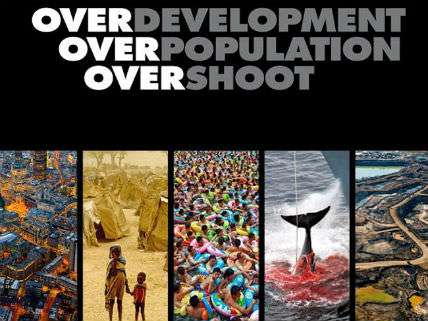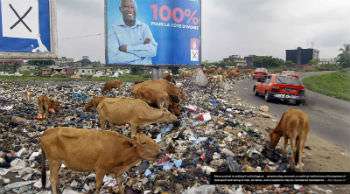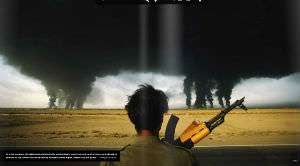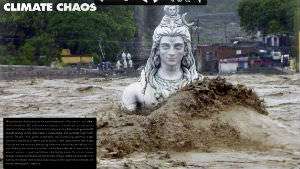The Big Coffee Table Book of Doom!
Neo-Malthusians again predict doom to celebrate Earth Day 45

Just in time for the 45th anniversary of Earth Day, populationspeakout.org aims to revive good old-fashioned overpopulation doom. The group has issued a 316-page coffee table book, Overdevelopment Overpopulation Overshoot, filled with spectacular photographs intended to alarm people about the problems created by growing human numbers. In fact, if you agree to scare your friends and neighbors the group will send you a copy as a free premium to display on your coffee table.
To illustrate the group's dire points, editor Tom Butler (of the Foundation for Deep Ecology) has arranged the photos into essays: "Human Tide," "Urban Animal," "Feeding Frenzy," "Material Planet," "Trashing the Planet," "Energy Blight," "Climate Chaos." The book opens with a photo of a giant Easter Island moai statues, which is supposed to represent "a civilization that overshot the land's carrying capacity." This is not an auspicious beginning. The parable of Easter Island ecocide has been strongly questioned by recent research, which finds that while changing rainfall led to population shifts on the island, it was European disease and enslavement, not population-driven warfare, that spurred the society's demographic collapse.
In his introduction, William Ryerson, the CEO of the Population Institute, makes the salient point that "women everywhere should have the means to time, limit, and space their pregnancies." He cites a United Nations estimate that that it would cost an additional $3.5 billion annually to provide modern contraceptive information and services to the more than 220 million women in the developing world who want to avoid a pregnancy. In addition, total fertility rates—the number of children a woman bears over the course of her life—are high in male-dominated cultures that exclude girls and women from schooling.
Nevertheless, the total global fertility rate has fallen from over 5 children per woman in 1970 to 2.45 today, rapidly approaching the 2.1 rate that is the threshold of population stability. The fact is that education is great contraception; the higher the female literacy rate, the lower a country's total fertility rate. And according to United Nations data, female adult literacy has increased from 70 percent in 1980 to over 82 percent today. Since 1980, literacy among women ages 15 to 24 has increased from 78 percent to 90 percent.
Longer life expectancy,lower infant mortality, and mass access to education, modern contraception, and market opportunities outside of the home are attainable only in countries where there is some measure of social peace and rule of law. If the global trend toward less violence continues, then opportunities for women to control their own fertility will grow.
Ryerson believes that it should be possible to stabilize world population at 8.3 billion by 2050. Basically, he is adopting the United Nations' low variant population projection, in which world population tops out at that figure and begins to decline to 6.7 billion by 2100. In a 2013 study, Spanish demographers Félix-Fernando Muñoz and Julio A. Gonzalo calculated that future population growth will most likely continue to track the U.N.'s low-variant trends. "Overpopulation was a spectre in the 1960s and '70s but historically the U.N.'s low fertility variant forecasts have been fulfilled," noted Muñoz.

Let's turn now to the images that are supposed alarm readers about overdevelopment and overpopulation. To illustrate the Human Tide, the book shows "a rising tide of humanity cover[ing] Ipanema Beach in Rio de Janeiro."
I have been on Ipanema Beach several times, and I have never seen the number of people in the photograph chosen by the editor to illustrate the supposed human tide. My best guess is that the photo was taken during the New Year's Day celebrations when throngs go to Ipanema for concerts and other festivities.

On my visits, I found the beach to be about as crowded as this.
Butler chooses a Google Earth aerial photograph of the New Delhi city grid to make the point that human beings are now "urban animals."

The caption for the New Delhi photo notes that the city has an average population density of 30,000 per square mile. Sounds bad, right? Not when you consider that the population density of Brooklynk averages 35,000 people per square mile. Manhattan's population density today is 70,000 people per square mile, down from 87,000 per square mile in 1910.

Butler is right that humanity is urbanizing. The United Nations estimates that 54 percent of the world's people now live in cities and that the percentage will increase to around 80 by 2050. But this is good news, not bad. Urban dwellers have greater access to education, market opportunities, and medicine, and they have fewer kids. Meanwhile, reducing the number of people tearing up the landscape as hardscrabble subsistence farmers ultimately means that more land can be set aside for nature.
This may interest the deep ecologist Eileen Crist, whose afterword in the book, decries "the near conversion of the biosphere into a human-food pantry."

Recent research by Jesse Ausubel and his colleagues at the Human Environment Program at Rockefeller University finds that humanity may have reached peak farmland. Agricultural productivity per acre is improving faster than the demand for food; as a result, fewer acres are needed to grow crops. These trends suggest that as much as 400 million hectares could be restored to nature by 2060, an area nearly double the size of the United States east of the Mississippi River.

Secondary forests like the one that surrounds my cabin in Virginia are now expanding on abandoned farmland.
The book focuses on "overshoot," the claim that humanity's numbers are now too great for the carrying capacity of the earth to sustain. Carrying capacity is defined as largest number of individuals of a particular species who can survive over long periods of time in a given environment, the level of which depends on the effect of the relevant limiting factors. As an illustration of human overshoot, the editor provides a photograph of women lined up to receive dollops of rice in a Somali refugee camp in Kenya:

Really? The fact that that Somalia has been in a state of civil war since 1991 might have some relevance to the prevalence of hunger in that country.
The photoessay "Trashing the Planet" is filled with graphic displays of the heedlessness with which people dispose of their garbage. All of the photos except one showing a tire dump in the United States are from poor developing countries.

Butler and his colleagues fail to acknowledge that trash disposal has been largely tamed in rich countries. A 1991 report for Resources for the Future once calculated that if the current rate of waste generation is maintained, all of America's garbage for the next 1,000 years would fit into a landfill measuring 120 feet deep and encompassing 44 square miles, about one-thousandth of one percent of the surface area of the United States.

A photograph of piled-up eucalyptus logs in Brazil is supposed to depict "Nature's Unraveling." Rather than offer up eucalyptus plantation forestry as an example of unraveling nature, Butler and his colleagues should instead be applauding it as yet another way humanity is decoupling from nature. Resources for the Future economist Roger Sedjo predicts that "by the middle of the twenty-first century most of the world's industrial wood will be produced from planted forests covering a remarkably small land area, perhaps only 5 to 10 percent of the extent of today's global forest." Again, human ingenuity produces more from less, sparing nature.
As an example of "Darkening Skies," the editor selects a photograph of burning oil refineries in Iran. Why were they burning? Because they had been bombed by Iraqis during the Iran-Iraq War. Somehow that doesn't seem like a pertinent illustration of overpopulation or overdevelopment.

In rich countries, skies are actually lightening. The Environmental Protection Agency reports that since 1980, emissions of carbon monoxide, nitrogen oxides, volatile organic compounds, particulates, and sulfur dioxide are down by 67, 52, 53, 50, and 81 percent respectively. The best evidence finds that increasing wealth from economic growth correlates with a cleaner natural environment. That is to say, richer becomes cleaner.
Global average temperatures have been going up, and most climate researchers are convinced that adding greenhouse gases to the atmosphere has contributed to that trend since the 1950s. To suggest the advent of "Climate Chaos," the editor chose a photograph of a major flood in the Uttarakand in 2013 that inundated a statute of the god Shiva.

Yet the United Nations Intergovernmental Panel on Climate Change's 2014 Synthesis Report notes that there is low confidence that climate change has so far affected any global trends toward increased flooding, hurricanes and typhoons, or droughts.
On the back of the book, physicist Albert Bartlett starkly asks: "Can you think of any problem in any area of human endeavor on any scale, from microscopic to global, whose long-term solution is in any demonstrable way aided, assisted, or advanced further increases in population, locally, nationally, or globally?" The folks at populationspeakout.org apparently think this is a devastating observation. But is it?
In his insightful 2013 book The Infinite Resource, the technologist Ramez Naam counters such thoughts with another question: "Would your life be better off if only half as many people had lived before you?" In this thought experiment, you don't get to pick which people are never born. Perhaps there would have been no Newton, Edison, or Pasteur, no Socrates, Shakespeare, or Jefferson. "Each additional idea is a gift to the future," Naam writes. "Each additional idea producer is a source of wealth for future generations." Fewer people means fewer new ideas about how to improve humanity's lot and to further decouple our endeavors from the natural world. "If we fix our economic system and invest in the human capital of the poor," Naam writes, "then we should welcome every new person born as a source of betterment for our world and all of us on it."
The goal of empowering women and girls is central to making the world a better place. It is the right thing to do regardless of the effects on future population trends, though the evidence does suggest that the results will please those worried about "overpopulation." Focusing just on the increase of human numbers is a distraction and misleads the public and policymakers from what really needs to be done for humanity and the natural world to flourish. Happy Earth Day 45!


Show Comments (180)